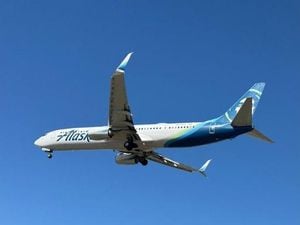A passenger plane operated by Air Busan caught fire just before takeoff at Gimhae International Airport, Busan, on January 28, 2025, leading to the emergency evacuation of 176 individuals onboard. The incident unfolded shortly before 10:30 p.m. local time, as the Airbus A321, bound for Hong Kong, was preparing for departure when flames erupted from the rear cabin.
Authorities reported all 169 passengers and seven crew members evacuated the aircraft via inflatable slides. Unfortunately, three people sustained minor injuries during the distressing escape, but thankfully, there were no serious injuries reported. Eyewitness accounts and footage from the scene revealed passengers rapidly sliding down the emergency chutes, whilst firefighters worked swiftly to extinguish the flames.
The response from fire service personnel was commendable, as they were alerted to the incident and arrived at the scene within eight minutes, immediately beginning efforts to control the blaze. "Footage aired by local broadcaster YTN showed evacuation slides deployed on both sides of the single-aisle plane," reported by Reuters. Fire authorities later revealed the fire initiated inside the plane’s tail before rapidly spreading.
This unfortunate event occurred less than a month after South Korea faced its deadliest aviation disaster when a Jeju Air plane crashed during its landing approach to Muan International Airport on January 2, killing 179 people. The stark proximity of these two incidents raises serious questions about aviation safety. Just days ago, the National Fire Agency reported findings related to the Jeju crash, which may include bird strikes and mechanical failures as possible causes.
Air Busan, as part of its parent company Korean Air, operates within South Korea's competitive budget airline market. It utilizes aircraft such as the Airbus A321, which has been involved in this latest incident. According to the Aviation Safety Network, the aircraft involved was 17 years old, having undergone numerous inspections and maintenance checks throughout its service. "The fire began inside the plane’s tail," stated fire authorities. Investigators will need to determine the precise cause of the ignition.
Following the evacuation and extinguishing efforts, images surfaced displaying significant fire damage, showing charred portions of the fuselage, including burn marks along the aircraft's roof. "All 169 passengers and seven crew members were evacuated, with three having minor injuries," said South Korea's Yonhap news agency. These visuals starkly demonstrate the challenges faced during the evacuation and the potential consequences had the situation escalated uncontrollably.
The importance of rapid and effective emergency responses cannot be overstated. This incident has raised fresh concerns about the emergency protocols employed by airlines during potentially life-threatening situations. Following the devastating crash of the Jeju Air jet, people and policymakers alike are increasingly focused on ensuring the safety of passengers and crew.
It remains to be seen what specific safety measures will be reviewed and implemented following this latest incident. Aviation experts often advocate for continued improvements in both aircraft technology and emergency response training for flight and ground crews alike.
Meanwhile, Air Busan and other airlines will undoubtedly be subjected to greater scrutiny. Airlines must continually assess their safety protocols and maintenance standards, at the forefront of public consciousness after the recent spate of incidents.
Authorities have initiated investigations to ascertain both the immediate cause of the fire and any broader systemic issues within Air Busan and the regional aviation industry.
While the fire on the Air Busan flight ended with no loss of life, such close calls compel all stakeholders, from the airlines to regulatory bodies, to remain vigilant against the risks posed by aviation operations. Any failure to adequately address these dangers could potentially jeopardize public safety and burden the industry with lasting reputational damage.



